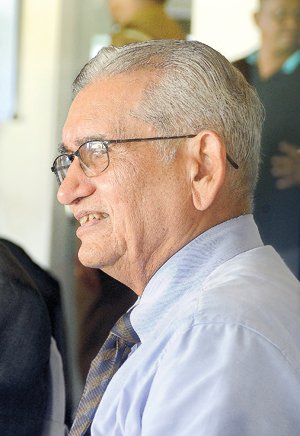Clean up the stables, there is young blood to take over – Michael Tissera
View(s):
The legendary Michael Tissera is all out in favour of the game - File pic by Amila Gamage
It’s almost ritualistic. From time immemorial, people have looked up to the wisdom of the senior generation for guidance. The reason: they have already experienced the pros and cons of similar situations and now, while looking at them from a different perspective, the elders see a broader view than we could ever fathom.
Looking at the present cricket conundrum, it’s the same. As for us at the Sunday Musings, there are three major occurrences in cricket. First was when Sri Lanka was admitted to the ivy league of cricket, as full member of the ICC, in 1981. Maximising or taking strength from that opportunity, Sri Lanka ran into become one of the youngest-ever teams to win the ICC World Cup in 1996. Now, almost a quarter century from that point, cricket in Sri Lanka is wobbling like a new ball and has lost direction. Cricket wise, the performances are not solid, while cricket governance is becoming despicable, the deterioration is rapid.
We looked to the wisdom of cricket doyen Michael Tissera to know from what aspect he sees this worsening situation, and what needs be done. We have an ICC deadline of February 9, 2019, to end this impasse. Once that is achieved, where do we go from there, we asked the former national captain? He said, “First of all, we have to change the constitution of Sri Lanka Cricket (SLC). There is no question about that. I think, even Sports Minister Faiszer Musthapha agrees with that point but, how he is going about it is a mystery. We have to bring down the SLC voting system to about 20 or 30. Now there are over 140 votes at the SLC AGM, just like Parliamentary elections. Thereafter, to sustain their position, they keep promising the moon and the earth. You get voted in and then it’s a matter of doling out money to keep the clubs happy, and they are not worried about the standard of cricket. For instance, even in India, a country far bigger than ours, there are only about 40 votes.”
Then, talking about the allegations of corruption within the SLC, Tissera said, “I think, within the previous Executive Committee there has been a lot of corruption. In fact, I was mentioning the other day that, besides changing the cricket constitution, there should have been an inquiry into the workings of the cricket board for the past couple of years. I hear some horrendous things have occurred, but nobody seems to be worked up about it.”
Then Tissera said there is sufficient young blood who have played the game at the highest level and who have been exposed to the work ethics of the ICC, and they are ready give a try at administration, if the authorities give them a clear stable.
Then we wanted to know how general cricket is faring. We pointed out, right now, Sri Lanka’s test cricket is faring okay, but the problem lies with the shorter versions of the game. To this poser, Tissera was firm in his stance. He asked, “Is our test cricket really okay?” and continued: “Yes, we have beaten Australia and have South Africa here but, if you look at it, we have beaten them on wickets that we prepared as slow turners. But, as soon as the wickets get better, we are not doing that well. This is where India is ahead of us. They have realised they can’t go on like this. They are preparing faster wickets and their cricket overseas has improved by leaps and bounds. They have started winning on faster wickets, they beat South Africa in South Africa and now they have got the better of England in their own backyard. Right now, they are producing three or four fast bowlers who are as good as anybody else! It’s about time even we followed suit. It’s okay to produce these wickets, to try and get your place secure in the ICC ladder, so that you will not be demoted, but sooner or later, we too will have to produce good wickets, so that we would be competitive wherever we play. If not, we are going to be left behind.”
Then we moved the focus to our own backyard, the local tournament, to seek ways of turning around. There, Tissera was bewildered more than convinced. He said, “First is the retiring of those top players and not finding proper replacements on time. But, of course, the administration should have been thinking ahead, they knew what was coming, but were not ready for it.”
“Having said that, I also say, to a great extent, our tournament structure is hopeless. It is one of the major drawbacks, and that is one reason our cricketers are not performing the way they should. If you have a strong domestic tournament, even though players retire, there will be others to fill the void. This has not happened.”
At that, we pointed out around 20 years ago, Sri Lanka had a solid club cricket base, where each club had its own cricket structure. There, a schoolboy could have joined at division III level, then move to division II level, before graduating to division I level. It was a system that worked well for Sri Lanka and it sustained our cricket for a great length of time. To this Tissera observed, “Unfortunately, it went by the wayside because, they brought on so many other clubs in. Club cricket was at its peak when there were only eight clubs. It was a natural system. Anybody who was not performing at the top level could go down to the second tier, perform and make a comeback, and automatically, the system sustained the bench strength. I know, at some clubs, school players complain that, after they get registered, they probably get one match and are dropped, and thereafter, they have no cricket at all. Because they are registered with that club, they cannot move to another. It’s a major drawback for the youngsters.”
 Then we drew his attention to provincial cricket. Even though we have been playing provincial cricket since 2001 or so, still it has not taken root. Up to now, it is a system of ‘Choose and cross your XI names for the province’, and nothing serious has come out of it. Tissera, a great admirer of the provincial cricket system, explained, “The reason for it is that the administrators have not conducted this tournament continuously. I think, it was first started in 2001, when we were running one of the Interim Committees. That was a very successful tournament. You ask Kumar Sangakkara, Muttiah Muralitharan or Mahela Jayawardena, they were all thrilled with the tournament. At the same time, we had sponsors for this tournament. Always, this argument of people being selected to fill the slots for the provincial tournament is there. But with sponsors to back it, if there was continuity, they would have been able to generate employment within the provinces. But, when you have the tournament for one year and don’t conduct it for the next five years, the system is bound to fail. Had they streamlined this tournament in a proper manner, during the past years, it may have been a successful tournament now.”
Then we drew his attention to provincial cricket. Even though we have been playing provincial cricket since 2001 or so, still it has not taken root. Up to now, it is a system of ‘Choose and cross your XI names for the province’, and nothing serious has come out of it. Tissera, a great admirer of the provincial cricket system, explained, “The reason for it is that the administrators have not conducted this tournament continuously. I think, it was first started in 2001, when we were running one of the Interim Committees. That was a very successful tournament. You ask Kumar Sangakkara, Muttiah Muralitharan or Mahela Jayawardena, they were all thrilled with the tournament. At the same time, we had sponsors for this tournament. Always, this argument of people being selected to fill the slots for the provincial tournament is there. But with sponsors to back it, if there was continuity, they would have been able to generate employment within the provinces. But, when you have the tournament for one year and don’t conduct it for the next five years, the system is bound to fail. Had they streamlined this tournament in a proper manner, during the past years, it may have been a successful tournament now.”
We pointed out, right now we do not have a proper provincial tournament which is established. We do not have a club tournament. It is not properly managed and riddled with strife, and the ultimate loser is our own cricket, which needs immediate remedial measures. Tissera pointed out, “True, at present, there is no direction to our domestic cricket at all. First, we should get back to our old system of three-tier club cricket as before, with only about 10 teams, and see where we could make ends meet”.


